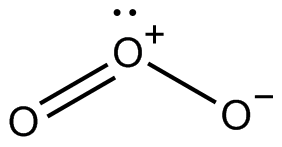
Oxidation number of oxygen atom in ${O_3} $ molecule is:
(A) 0
(B) -2
(C) +2
(D) +1
Answer
219.9k+ views
Hint: Oxygen being a reactive non- metal occurs in various forms, ozone is also one of the highly reactive gas made up of 3 oxygen atoms. It is both a natural and a man-made product that occurs in the earth’s upper atmosphere (stratosphere) and lower atmosphere (troposphere).
Complete step by step solution:
We have been provided with ${O_3} $ molecule,
As we know the molecular formula of ozone is ${O_3} $, that is 3 oxygen atoms,
The atomic number of oxygen is 8 and its valency is -2, as it requires 2 electrons to complete its octet.
The structure of ozone is:

Now, as we know, the oxidation number is the total number of electrons that an atom either gains or loses in order to form a chemical bond with another atom. It is also known as oxidation state.
So, we need to find out the oxidation number of ozone, for that we will be using the formula:
Charge on each atom/ number of atoms
Now, we have 3 oxygens having charges 0, -1 and +1.
So, the oxidation number would be: $\dfrac {{0 + (- 1) + (+ 1)}}{3} $,
On simplifying further, we will get: $\dfrac {0}{3} = 0$,
So, the oxidation number comes out to be 0.
Therefore, we can conclude that option (A) is correct.
Note: Ozone being highly reactive do have resonance structure but it would not change the oxidation number. Also, all the electrons of ozone are paired unlike oxygen and therefore it is diamagnetic.
Complete step by step solution:
We have been provided with ${O_3} $ molecule,
As we know the molecular formula of ozone is ${O_3} $, that is 3 oxygen atoms,
The atomic number of oxygen is 8 and its valency is -2, as it requires 2 electrons to complete its octet.
The structure of ozone is:

Now, as we know, the oxidation number is the total number of electrons that an atom either gains or loses in order to form a chemical bond with another atom. It is also known as oxidation state.
So, we need to find out the oxidation number of ozone, for that we will be using the formula:
Charge on each atom/ number of atoms
Now, we have 3 oxygens having charges 0, -1 and +1.
So, the oxidation number would be: $\dfrac {{0 + (- 1) + (+ 1)}}{3} $,
On simplifying further, we will get: $\dfrac {0}{3} = 0$,
So, the oxidation number comes out to be 0.
Therefore, we can conclude that option (A) is correct.
Note: Ozone being highly reactive do have resonance structure but it would not change the oxidation number. Also, all the electrons of ozone are paired unlike oxygen and therefore it is diamagnetic.
Recently Updated Pages
Electricity and Magnetism Explained: Key Concepts & Applications

JEE Energetics Important Concepts and Tips for Exam Preparation

JEE Isolation, Preparation and Properties of Non-metals Important Concepts and Tips for Exam Preparation

JEE Main 2021 July 25 Shift 1 Question Paper with Answer Key

JEE Main 2021 July 22 Shift 2 Question Paper with Answer Key

States of Matter Chapter For JEE Main Chemistry

Trending doubts
JEE Main 2026: Application Form Open, Exam Dates, Syllabus, Eligibility & Question Papers

Derivation of Equation of Trajectory Explained for Students

Hybridisation in Chemistry – Concept, Types & Applications

Understanding the Angle of Deviation in a Prism

Understanding Atomic Structure for Beginners

How to Convert a Galvanometer into an Ammeter or Voltmeter

Other Pages
NCERT Solutions For Class 11 Chemistry Chapter 7 Redox Reaction

JEE Advanced Marks vs Ranks 2025: Understanding Category-wise Qualifying Marks and Previous Year Cut-offs

Thermodynamics Class 11 Chemistry Chapter 5 CBSE Notes - 2025-26

NCERT Solutions ForClass 11 Chemistry Chapter Chapter 5 Thermodynamics

Hydrocarbons Class 11 Chemistry Chapter 9 CBSE Notes - 2025-26

Equilibrium Class 11 Chemistry Chapter 6 CBSE Notes - 2025-26




